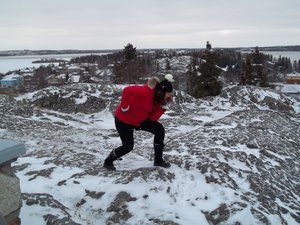Advertisement
Published: November 1st 2012

 The Law-Student Thinker
The Law-Student Thinker
Me pondering the wise words of Justice Sissons on a chilly winter's day!I’d like to do something a little different for this Blog posting. I have just finished reading the autobiography,
Judge of the Far North: The Memoirs of Jack Sissonsfor my essay assignment and would like to recommend it to all my readers, suggest it as mandatory reading for all Windsor Law Students chosen to participate in the Northwest Territories Clerkship, and tell you a bit about it in the form of a book review.
First of all, to be quite honest, I did not have to read the entire book to gain the relevant insights required for my essay. However, I just couldn’t put it down! The way the late Judge describes the landscape, culture, and beauty of the Northern people was just too fascinating for me to just skim over! Further, he has an extremely ironic and sarcastic way of describing his run-ins with the Federal Government and the Department of Northern Affairs which provides for much amusement. Therefore, over the past two weeks I have used the book as a sort of incentive to continue to attempt to research family law cases and pertinent issues which admittedly is not my interest.
Ok, I just looked up how to write a formal book review and I am not going to do that. Too boring and theoretical for me! (Ha ha!) I am just going to leave you with some information and general impressions.
Judge Jack Sissons was appointed the first Judge of the Territorial Court of the Northwest Territories in 1955. He was 63. In the book he writes, “The district of Canada is comparable to the county courts of England whose origin is traced back to the principle that ‘justice should be taken to every man’s door, by constituting as many courts as there are were manors in the Kingdom” (Page 54) and this philosophy he took with him when he began to sit court in all the far regions of the then Northwest Territories. (Ie- before the creation of Nunavut)
Further, he had this to say about bringing justice to every man’s door which I think is still relevant today and should be considered (along with the drastic and still far reaching effects of the residential school system) by legislators, the judiciary, and lawyers alike when sitting court in remote Northern areas: “The territorial court made some discoveries about the principle of bringing justice to every man’s door. It is not entirely a matter of geographical accommodation. When you reach the man’s door you must conduct the court to encompass his concepts of justice. I should like to emphasize the word “encompass.” What you take to his door is not downgraded or demeaned. It is enlarged- to accommodate concepts of right and of justice developed by another culture.” (Page 123)
This is a principle that Judge Sissons practiced and preached as the sole Judge of the Northwest Territories for eleven years. The Eskimo people gave him this nickname, “Ekoktoegee.” Which is pronounced “Uh-Coke-Toe-Gee.” He was given the nickname because of his unusual and somewhat controversial practice of allowing the Eskimo custom of seeking corroboration from the crowd while giving evidence. He describes a trial at Igloolik in which two brothers were charged with murder in the death of their father, in which the witnesses made frequent appeals to the spectators, and a spectator once got up and corrected a witness. He did not interfere with the coaching, or with the discussion among the spectators. This was the normal Eskimo way of getting at the truth. As he observed at page 126, “They were trying to find the whole truth of the matter, just as the court was, and since our aims were identical it was proper for the court to enlarge its rules to encompass their method.” Ekoktoegee means, “The One Who Listens to Things” and children used to shout it when the Territorial Court plane would land in their communities.
His book regales tales of trials conducted regarding the Eskimo practice of suicide and how assisted suicide would not be considered “illegal” in their culture, feuds with Northern Affairs over the callous disregard of the Indian Act when they legislated against Eskimos practicing their inherent hunting rights, the lack of resources for defense of the accused, woes about language interpretation, and the astonishing and racially motivated disregard of traditional Eskimo marriages by the parliament of the day.
The book would be considered dated now as it was published in 1965. However, his keen eye for the role of the independent judiciary, beautiful descriptions of the vast northern landscape, and observation of the pitiful conditions of the Eskimo people are still relevant for a law student (or information seeker?!) in 2012.
Now, some of you who know my general feelings on Aboriginal Affairs may say, “Uh, Sarah, do you just like this book because you unilaterally agree with him?” And the answer to that is, well, admittedly yes, I do agree with him, but believe the book is wonderfully written. He just is able to articulate the opinion I have been trying to put forward for the last two years and back it up with appropriate legal argument and an extreme respect (not a Eurocentric) view of the Eskimo culture! Trust me, it is a good read. I am going to buy the book for myself, so any interested blog readers can just ask me to borrow it when I come back to the warm South. (As it is currently -14 here)
I will leave you with his final paragraphs regarding the formal boundary of North West Territories,
“The Northwest Territories is a harsh, magnificent land, a land of attractive challenge, a comforting and satisfying land, where the Mackenzie delta fans out in a land-locked archipelago; where the wind of the Beaufort Sea rushes over Tuktoyuktuk; where the western Chinooks are occasionally pushed down the Mackenzie valley, and the tides sweep thirty feet high into Pangnirtung Fiord. The grass grows Irish green on the hills of Pond Inlet, masses of very beautiful, delicate and rare Arctic flowers of infinite variety carpet the barrens during the brief summers; and the caribou flow in ceaseless migration. There, the subsoil is in permanent frost, and the golf tournament on July 21
st begins at midnight; and somewhere as I write, the Flag of the Territorial Court may be flying.
Thirty-four percent of Canada is in that land. It is a land of great riches not half discovered, and greater promise not half fulfilled.” (Page 190)
Well said Ekoktoegee, well said.
Advertisement
Tot: 0.078s; Tpl: 0.01s; cc: 7; qc: 48; dbt: 0.0414s; 1; m:domysql w:travelblog (10.17.0.13); sld: 1;
; mem: 1.1mb







